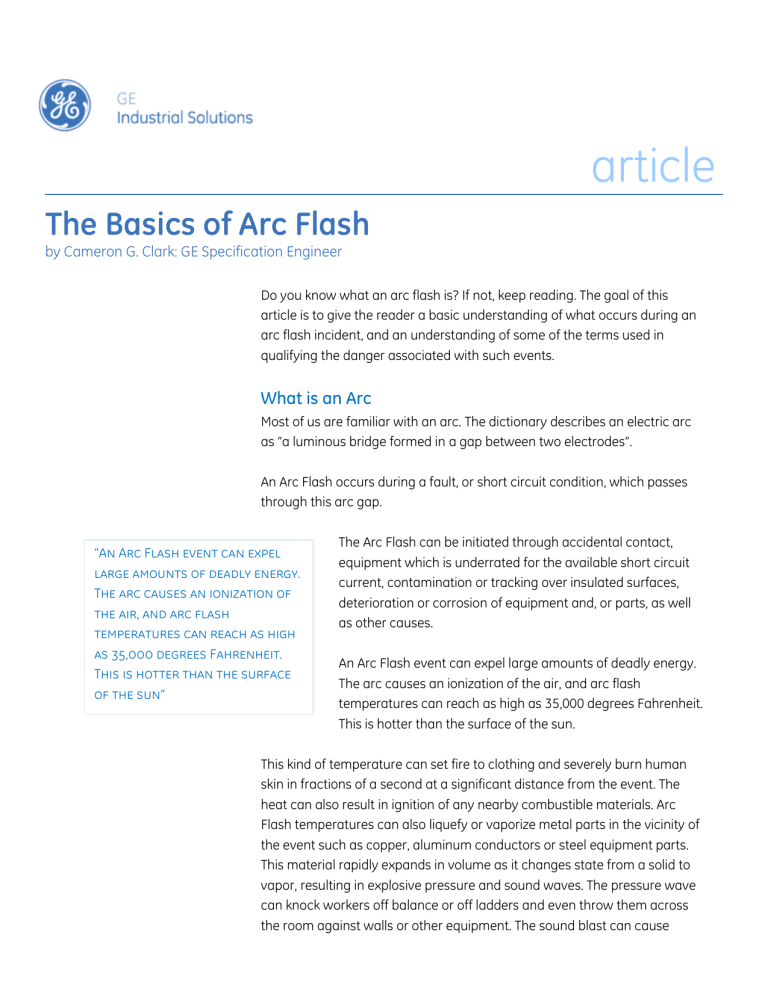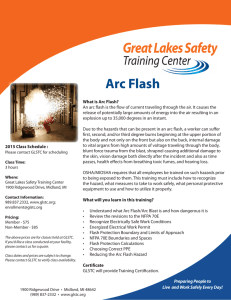GE-The-Basics-of-Arc-Flash-Article GE Industrial Solutions 0
advertisement

article The Basics of Arc Flash by Cameron G. Clark: GE Specification Engineer Do you know what an arc flash is? If not, keep reading. The goal of this article is to give the reader a basic understanding of what occurs during an arc flash incident, and an understanding of some of the terms used in qualifying the danger associated with such events. What is an Arc Most of us are familiar with an arc. The dictionary describes an electric arc as “a luminous bridge formed in a gap between two electrodes”. An Arc Flash occurs during a fault, or short circuit condition, which passes through this arc gap. “An Arc Flash event can expel large amounts of deadly energy. The arc causes an ionization of the air, and arc flash temperatures can reach as high as 35,000 degrees Fahrenheit. This is hotter than the surface of the sun” The Arc Flash can be initiated through accidental contact, equipment which is underrated for the available short circuit current, contamination or tracking over insulated surfaces, deterioration or corrosion of equipment and, or parts, as well as other causes. An Arc Flash event can expel large amounts of deadly energy. The arc causes an ionization of the air, and arc flash temperatures can reach as high as 35,000 degrees Fahrenheit. This is hotter than the surface of the sun. This kind of temperature can set fire to clothing and severely burn human skin in fractions of a second at a significant distance from the event. The heat can also result in ignition of any nearby combustible materials. Arc Flash temperatures can also liquefy or vaporize metal parts in the vicinity of the event such as copper, aluminum conductors or steel equipment parts. This material rapidly expands in volume as it changes state from a solid to vapor, resulting in explosive pressure and sound waves. The pressure wave can knock workers off balance or off ladders and even throw them across the room against walls or other equipment. The sound blast can cause eardrums to rupture resulting in temporary or permanent hearing loss. Molten metal can be sprayed by the blast throughout the vicinity. Solid metal debris and other loose objects, such as tools, can be turned into deadly projectiles by the explosion. The bright flash from the event can result in temporary or permanent blindness. All of these will most likely result in equipment damage as well as personnel injury, and possibly death. Code Description Section 110.16 of the 2008 National Electrical Code requires that electrical equipment be marked to warn qualified personnel of potential arc flash hazards. In order to accurately evaluate the dangers associated with arc flash we must quantify the hazard. The measure, which has been developed to assess arc flash events, is incident energy. This is the energy measured on a surface at a specified working distance from the arc flash location. “Those involved with the design, implantation and evaluation of electrical distribution systems mush have an understanding of arc flash hazards and how to evaluate the hazards as well as minimize or mitigate the hazard to the electrical worker.” For low voltage equipment this is 24 inches, and approximately corresponds to the arm length of a typical worker. The unit used to quantify this energy is cal/cm2. A value of 1.2 cal/cm2 results in 2nd degree burns to bare skin, and 8 cal/cm2 in 3rd degree burns. The incident energy is inversely proportional to the square of the working distance, and directly proportional to the available fault current and duration of an arc flash event. Some of the other factors which affect incident energy of an arc flash event are the short circuit current available, both from the utility and at specific bus locations in the distribution system, cable size and length, the type of over current protective devices, and the settings of those over current protective devices. The device settings directly influence the duration of the fault for a given value of arc fault current. For this reason there is interest by many, these days, in a temporary second group of setting which reduce the time a breaker takes to clear a fault when a person is working on energized equipment. This can often reduce the hazard significantly. General Electric offers this capability in the Reduced Energy Let Through mode (RELT) of the Entelliguard® TU trip unit. Arc Flash Studies In order to identify the specific arc flash hazard at a given piece of equipment within a facility, an arc flash study must be performed. There are several software packages available, similarly to short circuit study and coordination study software packages, to facilitate this analysis by a qualified professional electrical engineer. In order to perform the arc flash study a short circuit and coordination study must first be performed or the results of these studies must be available to the engineer performing the arc flash study. The result of the arc flash study will categorize the hazard at specific equipment based on the incident energy, as well as identify the Arc Flash Protection Boundary (this is the closest approach allowed before PPE must be worn). Inside the Arc Flash Protection Boundary a worker must be wearing the proper clothing, or Personal Protective Equipment (PPE). The main objective of the PPE is to limit the burns to the body resulting from an arc flash event, to a survivable level. (i.e .2nd degree or less). Hazard Risk Categories as outlined in NFPA 70E are as follows: Gloves, footwear and face protection appropriate to the hazard risk category must be used as well. Arc Flash Hazard is a subject that is undergoing increased discussion and scrutiny in today’s safety conscious environment. The intent of the standards in this area is to provide an increased level of safety for the electrical worker. Product Information For product information, placing orders or inquiring about an existing order, call: 1-800-431-7867 or 1-800-GE-1-STOP www.geindustrial.com Those involved in the design, implantation and evaluation of electrical distribution systems must have an understanding of Arc Flash Hazards and how to evaluate the hazards as well as minimize or mitigate the hazard to the electrical worker.

